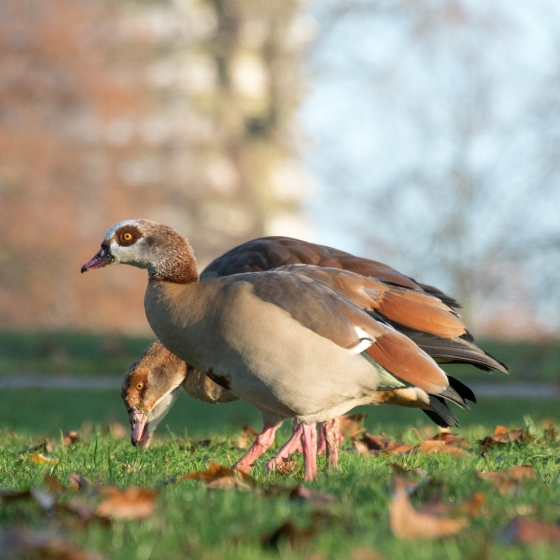Egyptian Goose
Alopochen aegyptiaca (Linnaeus, 1766)
EG
 EGYGO
EGYGO  1700
1700

Family: Anseriformes > Anatidae

The Egyptian Goose is a loud and rather striking goose, most familiar to birdwatchers in East Anglia and the south-east of England.
This 17th century introduction to England has only relatively recently shown significant expansion in its numbers and distribution. In 1991 the population was estimated at c.900 individuals, 91% of which were in Norfolk. Since then, the species has colonised the rest of East Anglia, much of London and parts of the Home Counties. Expansion into the East Midlands is the likely next step.
Egyptian Geese breed very early in the year, and favour large old trees with suitable cavities for nesting. With the male in attendance close by during incubation, breeding pairs are readily found.
Identification
Egyptian Goose identification is usually straightforward.
SONGS AND CALLS
Listen to example recordings of the main vocalisations of Egyptian Goose, provided by xeno-canto contributors.
Flight call
Call
Develop your bird ID skills with our training courses
Our interactive online courses are a great way to develop your bird identification skills, whether you're new to the hobby or a competent birder looking to hone your abilities.
Browse training coursesStatus and Trends
Population size and trends and patterns of distribution based on BTO surveys and atlases with data collected by BTO volunteers.
POPULATION CHANGE
This non-native species originally established a self-sustaining population in Nofolk, but has increased both its range and its population over the last 50 years. A second core population has been established around Greater London with scattered records elsewhere in the south and east (see Atlas maps), and it is now sufficiently widespread that the short-term trend can be measured by BBS, with the ten-year trend graph confirming the rapid increase in numbers. Expanding populations of geese, including non-native Canada Geese, are creating a number of economic, social and environmental challenges and, increasingly, adaptive policies are required to manage invasive goose populations in order to minimise and mitigate economic and environmental impacts (e.g. Reyns et al. 2018).
| UK winter population |
+550% increase (1996/97–2021/22)  |
DISTRIBUTION
The distribution maps show that Egyptian Geese are now found in two main areas: East Anglia and an area centred on Greater London extending into parts of neighbouring counties. There is a suggestion that the East Midlands may develop into a third stronghold area, with a wide scattering of records there in both seasons. Away from these key areas there are isolated records as far north as Shetland, west Wales, southwest England and Ireland, with most of these records in winter.
Occupied 10-km squares in UK
| No. occupied in breeding season | 232 |
| % occupied in breeding season | 7.7 |
| No. occupied in winter | 393 |
| % occupied in winter | 13 |
European Distribution Map
DISTRIBUTION CHANGE
The reason for the expansion over the last 20 years is unknown, though is probably fuelled by an increasing population in East Anglia leading to wider dispersal.
Change in occupied 10-km squares in the UK
| % change in range in breeding season (1968–72 to 2008–11) | +1172.2% |
| % change in range in winter (1981–84 to 2007–11) | +423.3% |
SEASONALITY
Egyptian Geese can be seen throughout the year in parts of southern and eastern England.

Movement
Information about movement and migration based on online bird portals (e.g. BirdTrack), Ringing schemes and tracking studies.
An overview of year-round movements for the whole of Europe can be seen on the EuroBirdPortal viewer.
RINGING RECOVERIES
View a summary of recoveries in the Online Ringing Report.
Foreign locations of birds ringed or recovered in Britain & Ireland

Biology
Lifecycle and body size information about Egyptian Goose, including statistics on nesting, eggs and lifespan based on BTO ringing and nest recording data.
SURVIVAL & LONGEVITY
View number ringed each year in the Online Ringing Report
Maximum Age from Ringing 
|
15 years 1 months 4 days (set in 2017) 
|
CODES & CLASSIFICATION
Ring size 
|
K or J* |
Field Codes 
|
2-letter: EG | 5-letter code: EGYGO | Euring: 1700 |
For information in another language (where available) click on a linked name
Research
Interpretation and scientific publications about Egyptian Goose from BTO scientists.
CAUSES AND SOLUTIONS
Causes of change
There is little good evidence available regarding the drivers of the breeding population increase in this species in the UK. However, the growth matches that of both Canada Goose and Greylag Goose and it is likely that the initial rapid increases following introduction was driven by similar factors. Factors behind its success in the Netherlands may have included the climate, the wide availability of suitable good quality grassland habitat and the fact that it has few natural enemies there (Gyimesi & Lensink 2010).
Links to more studies from ConservationEvidence.com
- Reintroduction of the critically endangered Campbell Island teal Anas nesiotis to Campbell Island, New Zealand
- Post-release survival of oiled, cleaned seabirds in North America
- Clutch size and nesting sites of the mandarin duck Aix galericulata
Read more studies about Egyptian Goose on Conservation Evidence >
Would you like to search for another species?











Share this page